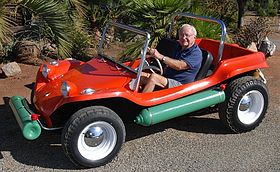Meyers Manx
| Meyers Manx | |
|---|---|

Bruce Meyers in a genuine Meyers Manx.
|
|
| Overview | |
| Manufacturer | Bruce F. Meyers individually (prototype) B. F. Meyers & Co. (main production) Meyers Manx, Inc. (modern revival) |
| Production | 1964–65 (prototype, 12 built) 1965–1971 (main, ~6,000 built) 1999–present (limited) |
| Assembly |
Newport Beach, California (prototype) Fountain Valley, California (main) Valley Center, California (revival) |
| Body and chassis | |
| Class |
Dune buggy Kit car |
| Body style | Open-wheeled |
| Layout | RR layout |
| Powertrain | |
| Engine | 1.2L VW H4, 1.3L VW H4, 1.5L VW H4, 1.6L H4 |
| Transmission | 4-speed manual transaxle, 2-wheel drive |
The Meyers Manx dune buggy is a small recreationally-oriented automobile, designed initially for desert racing by Californian engineer, artist, boat builder and surfer Bruce F. Meyers. It was produced by his Fountain Valley, California company, B. F. Meyers & Co. from 1964 to 1971, in the form of car kits applied to shortened chassis of Volkswagen Beetles. The car line dominated dune racing in its time, breaking records immediately, and was eventually also released in street-oriented models, until the company's demise due to tax problems after Meyers's departure. New vehicles inspired by the original Manx buggy have been produced by Meyers's re-founded operation, Meyers Manx, Inc., since 2000. The name and cat logo of the brand derives from the Manx cat, by virtue of the tailless breed's and the shortened vehicle's truncated "stubbiness".
Drawing on his experience in sailboat construction, Meyers personally modeled and built his first dune buggy, "Old Red", a shortened VW Beetle with a monocoque, fiberglass shell and an IRS trailing arm suspension, in late 1963 to May 1964 in his garage in Newport Beach, California. The first known street-legal fiberglass dune buggy, it featured a unibody shell that fused body, fenders and frame, retaining just the engine, transmission and other mechanicals of the VW. The use of compound curves throughout provided great rigidity. The fenders were arched high, to make room for large, knobby dirt-racing wheels.
...
Wikipedia
